Kaye Lynne Booth's Blog: Writing to be Read, page 14
March 25, 2025
In Touch With Nature – Nyala antelope #southernAfricanwildlife
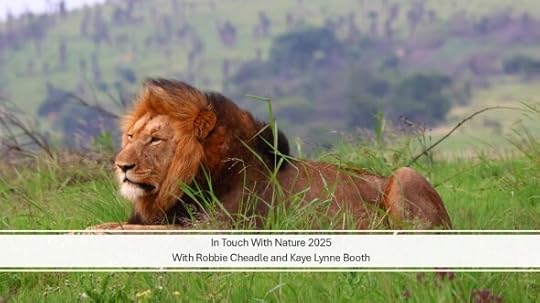
The Nyala is a spiral horned antelope native to southern Africa. It is the antelope with the highest sexual dimorphism (differences between male and female of the species). This is easy to see in the photographs and videos I’ve shared in this post so look out for the rusty or rufous brown coats of the females and juveniles and the dark brown or slate grey coat of adult males. Females and juveniles also have ten or more white vertical stripes on their sides which the stripes are greatly reduced or completely absent in the adult males. The males are significantly larger than the females.
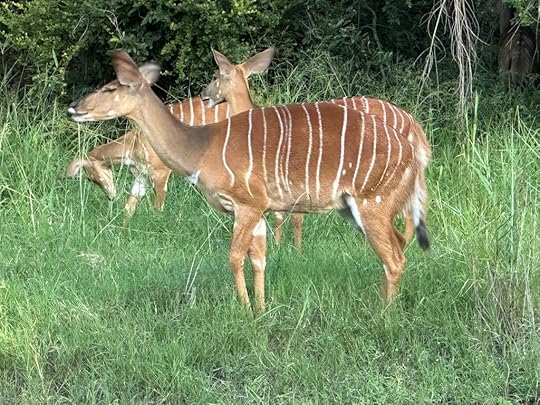 Picture caption: Female Nyala with vertical white stripes
Picture caption: Female Nyala with vertical white stripes
 Picture caption: Young male Nyala
Picture caption: Young male Nyala
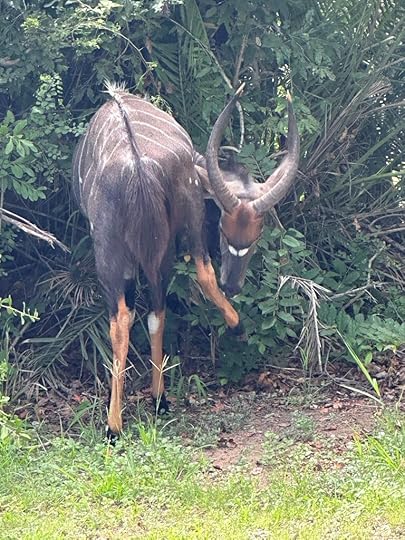 Picture caption: Above and below are pictures of a male Nyala
Picture caption: Above and below are pictures of a male Nyala
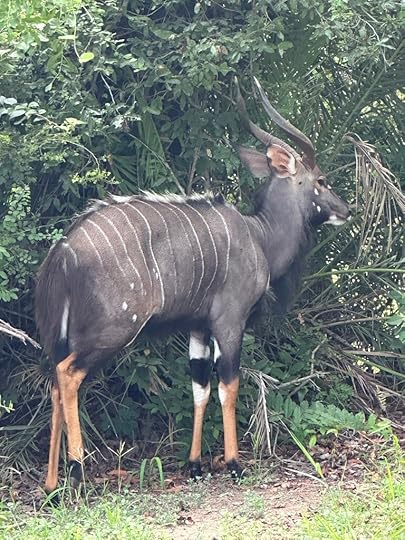
The Nyala is a shy animal and is usually seen in the early morning and the late afternoon when it browses, feeding on foliage, fruits, and grasses. They live in thickets within dense and dry savannah woodlands and are usually found in single-sex or mixed family groups of up to ten animals. These antelope are not fast runners, and their camouflage is their main defense against predators.
The main predators of the Nyala are lions, leopards, African wild dogs, and humans. The males are highly prized as game animals, and they are often victims of poaching. Human settlement is also encroaching on their habitat resulting in a declining population although they are classified as Least Concern by the International Union for Conservation of Nature (IUCN).
Nyalas have a special relationship with the baboons and vervet monkeys with whom they share the woodlands. They eat any fruit dropped by these primates and also react to any alarm calls made by primates from their advantageous viewing points in the trees. The baboons and monkeys also benefit from the relationship as Nyala have exceptional hearing, smell, and sight. When a Nyala spots danger, it gives off a striking alarm call sounding a bit like a barking dog. This warning also serves the primates and other creatures sharing their habitat.
Interestingly, Nyalas are not territorial. They wander about in groups and do not try to protect any areas from other creatures.
Nyala buck have an aggressive way of breeding. Firstly, the males fight for dominance, crashing into each other with their sharp horns acting like swords. The horns often draw blood. The bulls fight until one backs down by walking away as a sign of submission. These battles can be fatal if the wounds become infected or if the bull is concussed. The winning bull then slowly dances within the group of females, using strange, stuttering movements and raising its head to show off its white underfur.
When a female is on heat, the male follows her on foot, pushing his nose between her legs. He gets excited and buts her hindquarters right off the ground. If the female is interested, she stops walking. The male then walks around her and presses her head down before he mounts her. Gestation is 220 days and ewes can conceive from the age of 14 months.
 Picture caption: Close up of a young male Nyala
Picture caption: Close up of a young male Nyala
 Picture caption: Close up of a female Nyala
Picture caption: Close up of a female NyalaYouTube video of Nyala herd comprising of young males and females:
Male Nyala licking his legs YT video:
YT video of a Nyala male feeding:
The Fire Part 1Flamboyant performer
Sun takes final bow
Pitch black curtains descend; concealing the stage
Campers assemble fire
Restraining darkness
***
Wood ignites, flames crackle
Illuminating
Nocturnal animals materialise
Skulking in deep shadow
Bright eyes glittering
***
Feeding ravenous blaze
An essential task
Stopping potential diners from helping themselves
To a convenient
Snack of arms or legs
Dawn makes her grand entrance
Painting the sky red
Men prepare to depart, water smothers fire
Murky vapour billows
Dark ashes sodden
***
Everything orderly
The campers move on
Single flickering coal smolders unnoticed
Mutely clinging to life
Nurtured by the breeze
***
Dry leaves fall stealthily
Embracing ember
Sustenance provided; leaves burst into flame
Cunningly building strength
Destruction ensured
These poem duo is from my book, Lion Scream, Syllabic Poetry About Southern African Wildlife, available from Amazon here: https://www.amazon.com/Lion-Scream-Syllabic-Southern-Wildlife-ebook/dp/B0BXP5N766
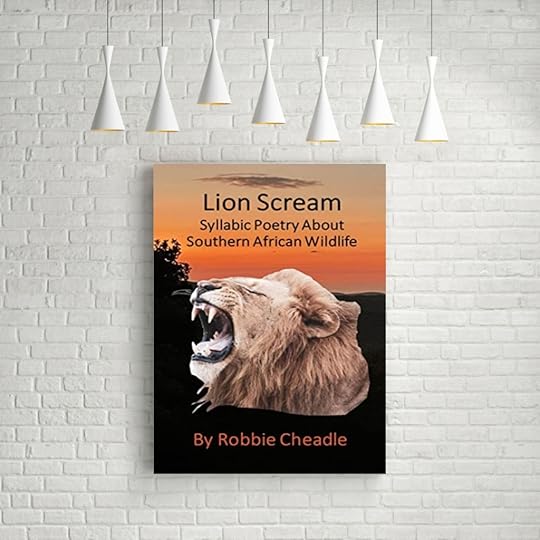 Picture caption: Promotional banner for Lion ScreamAbout Roberta Eaton Cheadle
Picture caption: Promotional banner for Lion ScreamAbout Roberta Eaton Cheadle
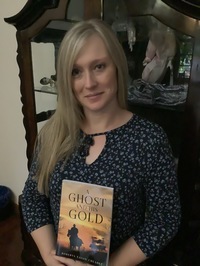
Roberta Eaton Cheadle, is a South African writer and poet specialising in historical, paranormal, and horror novels and short stories. She is an avid reader in these genres and her writing has been influenced by famous authors including Bram Stoker, Edgar Allan Poe, Amor Towles, Stephen Crane, Enrich Maria Remarque, George Orwell, Stephen King, and Colleen McCullough.
Roberta has two published novels and a collection of short stories and has horror, paranormal, and fantasy short stories included in several anthologies. She is also a contributor to the Ask the Authors 2022 (WordCrafter Writing Reference series).
Roberta is also the author and illustrator of sixteen children’s books, illustrator to a further three children’s books, and the author and illustrator of three poetry books published under the name of Robbie Cheadle, and has poems and short stories featured in several anthologies under this name.
Roberta’s blog features discussions about classic books, book reviews, poetry, and photography. https://roberta-writes.com/.
Find Roberta Eaton CheadleBlog: https://wordpress.com/view/robertawrites235681907.wordpress.com
Bluesky: https://bsky.app/profile/robbiecheadle.bsky.social
Facebook: https://www.facebook.com/robertawrites
Amazon: https://www.amazon.com/Roberta-Eaton-Cheadle/e/B08RSNJQZ5
___________________________________________
Like this post? Are you a fan of this blog series? Did you know you can sponsor your favorite blog series or even a single post with an advertisement for your book? Stop by the WtbR Sponsor Page and let me advertise your book, or you can make a donation to Writing to be Read for as little as a cup of coffee, If you’d like to show your support for this author and WordCrafter Press.
__________________________________________
This segment of “In Touch with Nature” is sponsored by the Midnight Anthology Series and WordCrafter Press .
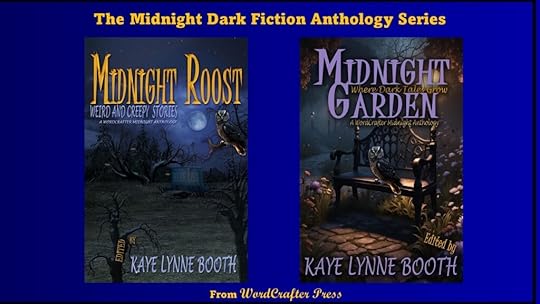
Midnight Roost: Weird and Creepy Stories: 20 authors bring your nightmares to life in 23 stories of ghosts, paranormal phenomenon and the horror from the dark crevasses of their minds. Stories of stalkers, both human and supernatural, possession and occult rituals, alien visitations of the strange kind, and ghostly tales that will give you goosebumps. These are the tales that will make you fear the dark. Read them at the Midnight Roost… if you dare. https://www.amazon.com/Midnight-Roost-Kaye-Lynne-Booth-ebook/dp/B0CL6FPLVJ
Midnight Garden: Where Dark Tales Grow: 17 authors bring you 21 magnificent dark tales. Stories of magic, monsters and mayhem. Tales of murder and madness which will make your skin crawl. These are the tales that explore your darkest fears. Read them in the Midnight Garden… if you dare. https://www.amazon.com/Midnight-Garden-Where-Tales-Anthology-ebook/dp/B0DJNDQJD3
March 24, 2025
Review in Practice: “Essoe’s Guides to Writing: Mood & Atmosphere”
I was received a digital copy of this writing reference as a part of the 2024 Novel Writing Story Bundle currated by Kevin J. Anderson, which also featured my writing reference, The D.I.Y. Author.
I recently started writing one of three stories that have been bouncing around in my head for the Curses themed anthology, which WordCrafter Press will put out in September of 2025, and I feel mood and atmosphere will be extremely important in telling the stories for this collection that I want to tell. The one I just started has a working title of “The Curse of the Death Clock” begins in France during the reign of Napoleon Bonaparte and the right atmosphere for the setting is going to be a challenge.
I read Essoe’s Guides to Writing: Mood & Atmosphere with the writing of the Curses stories in mind and I’ll be keeping them in the forefront of my mind as I write this first story. To try and set the right mood and atmosphere for these Curses stories, I’ve implemented the exercise in Chapter 3 and started a word list which aligns with the mood I’m going for, which is slight unease and a feeling of doom. As with all the tools in my writing tool box, I’ll keep all my new tools on hand as I write the other two stories.
However, as I read, I found suggestions that can be use to improve mood and atmosphere in by taking another look at my sentence structure and word choices, as well as my pacing, in my latest WIP, The Rock Star & The Outlaw 2: Seeing Doubles, which I just got back from my beta reader and I’m preparing to do a final edit. I’m using another exercise from Chapter 3 to help nail the pacing for this story, which is very fast, with lots of action, making a list of keywords from a story which evoked a strong emotional reaction, which I’m aiming for in my own tale. The book I’ve chosen is Velocity, by Dean Koontz. The man is a master of suspense and knows how to keep the pages turning. I’ll also be taking another look at the conflicts in this story for parallels and counterpoints to the main conflict. Essoe includes many useful writing exercises to illustrate his points and can be used with WIPs, to improve on current projects.
I found useful exercises in chapter four on setting and atmosphere which I plan to utilize with yet another story, an out and out horror for Midnight Oil. Robbie is helping me with the research on this one, since it involves zombie elephants. Because of the subject area, the setting will be one that I am unable to visit and experience for myself. Robbie’s expertise will be a great help in this area, but I’m going to have to work to achieve the right atmosphere, and “The Shorthand” exercise will be useful. I’ll be taking note of possible points of interest and the emotional impact it has on my characters when describing the South African savannah setting. Most of my characters move my stories forward through action and dialog, but I think in this story, their internal reactions will be particularly important.
I’m picking and choosing the pieces that I feel I need to work on in the stories I’m working on for 2025, but Essoe gives us a list of eight tools which make up mood and atmosphere, and suggests that we should use at least five of them in every story we write to develop a strong, purposeful mood. In The Rock Star & The Outlaw 2: Seeing Doubles, I think I have a few already in place, so I’ll be working on those I may be missing. With the Curses and Midnight Oil stories, I’ll be implementing these tools from the start. The other story I have planned for 2025 is the third book in my Women in the West adventure series, Marta, and while I’ve begun an outline for that novel, it requires such a completely different mood that I think I’ll hone my skills with the other stories first, but I know I’ll be referring back to Essoe’s Writing Guides: Mood & Atmosphere when the time comes to get that one on the page.
About Essoe’s Guides to Writing: Mood & AtmosphereMood and Atmosphere defines and delves into the 8 primary tools used to create the emotional framework of your story–its emotionality–by breaking them down into easy-access chapters on:
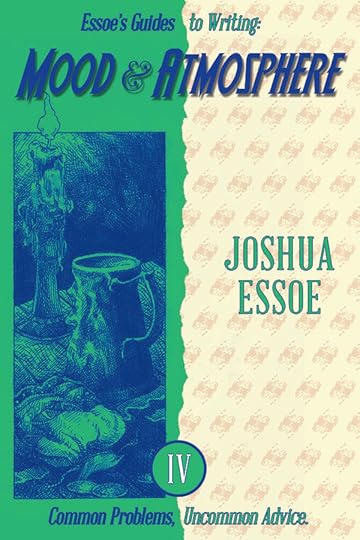 Plot and structure blueprinting your intended emotionalityPacing that steers your story line-by-line and chapter-by-chapterLanguage and word choice guiding your story in the most direct relationship with readersSetting developing an atmosphere that will make readers experience your worldCharacter expression creating powerful moods that will make readers feel their traumas and triumphsConflict controlling the ebb and flow of your emotionality throughout your storyTheme acting as the conductor, setting your emotionality to a purposeReader expectation and what promises you must keep or can use to throw in twists
Plot and structure blueprinting your intended emotionalityPacing that steers your story line-by-line and chapter-by-chapterLanguage and word choice guiding your story in the most direct relationship with readersSetting developing an atmosphere that will make readers experience your worldCharacter expression creating powerful moods that will make readers feel their traumas and triumphsConflict controlling the ebb and flow of your emotionality throughout your storyTheme acting as the conductor, setting your emotionality to a purposeReader expectation and what promises you must keep or can use to throw in twists Purchase Link: https://www.joshuaessoe.com/product-page/mood-and-atmosphere-e-book-1
About Kaye Lynne Booth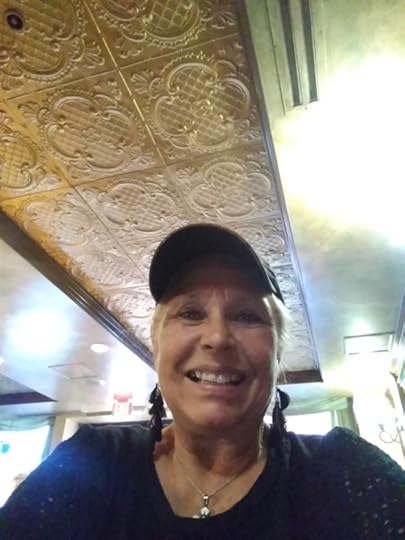
For Kaye Lynne Booth, writing is a passion. Kaye Lynne is an author with published short fiction and poetry, both online and in print, including her short story collection, Last Call and Other Short Fiction; and her paranormal mystery novella, Hidden Secrets; Books 1 & 2 of her Women in the West adventure series, Delilah and Sarah, and her Time-Travel Adventure novel, The Rock Star & The Outlaw, her the first three books in her kid’s book series, My Backyard Friends, her poetry collection, Small Wonders, and her writer’s resource, The D.I.Y. Author. Kaye holds a dual M.F.A. degree in Creative Writing with emphasis in genre fiction and screenwriting, and an M.A. in publishing. Kaye Lynne is the founder of WordCrafter Quality Writing & Author Services and WordCrafter Press. She also maintains an authors’ blog and website, Writing to be Read, where she publishes content of interest in the literary world.
____________________________________
Did you know you can sponsor your favorite blog series or even a single post with an advertisement for your book? Stop by the WtbR Sponsor Page and let me advertise your book, or you can make a donation to Writing to be Read for as little as a cup of coffee, If you’d like to show your support for this author and WordCrafter Press.
____________________________________
This segment of “Review in Practice” is sponsored by the Women in the West Adventure Series and WordCrafter Press.
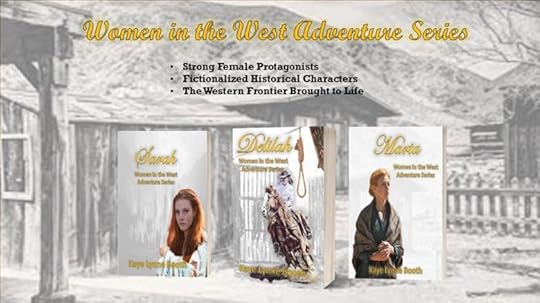
Historical Women’s Fiction
Get Your Copy Today!
Delilah: https://books2read.com/DelilahWiW1
Sarah: https://books2read.com/Sarah-Women-in-the-West
Marta: Coming in 2025
March 22, 2025
Chatting with New Blood: Science Fiction Author, Nathan Gregory
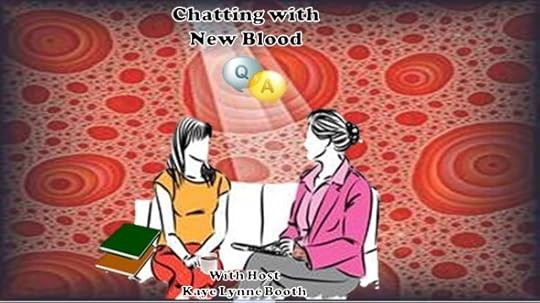 About Nathan Gregory
About Nathan GregoryA lifelong explorer of science fiction, I’ve been captivated by the wonders of space and technology since childhood. My early days were spent imagining journeys to Mars, the Moon, and beyond through the stories of classic authors like Robert Heinlein and Edgar Rice Burroughs. Today, I channel that same sense of wonder and adventure into my writing.

With a background as an engineer specializing in networking, data communications, privacy, and cybersecurity, my professional career has kept me on the cutting edge of technology—fields that fuel my fascination with the future. In recent years, I’ve expanded my expertise into encryption, cryptocurrency, and digital identity protection, adding real-world depth to the speculative worlds I create.
Since 2015, I’ve been writing the kind of science fiction I love to read: cosmic adventures, tales of rogue AIs, distant worlds, and alien encounters. My stories explore the intersection of technology and humanity, where humor, suspense, and the unexpected come together in thrilling ways.
Whether you’re a fan of classic space operas or modern sci-fi with a twist, I invite you to join me on these journeys to the far reaches of the universe.
My Interview with Nathan GregoryKaye: A science fiction buff mesmerized by the reaches of space with an engineering background. It’s easy to see why you write hard science fiction, so I won’t ask that question, but please tell us a little about your journey to become and author.
Nathan: One of my earliest memories is lying in the grass with my dad, staring up at the night sky as Echo 1—the ‘Satelloon’—glided overhead. It launched August 12, 1960, so I figure we caught it shimmering across the stars sometime that mid-August. I was hooked. I’d always been the kid tinkering with gadgets and gears, but that moment ignited a lifelong obsession with technology—especially anything tied to electronics or space.
From there, I devoured every book and story I could find about science and exploration. Space travel? I was all in—pulled like a tractor beam. I’d been reading wild, fantastic tales since I could decode letters on a page. Tom Swift, Rick Brant, Heinlein juveniles, and somewhere in the back of my mind, I always thought, ‘I want to write these someday.’
But authorship stayed a daydream until 2015, when I finally sat down and hammered out my first story. I tossed it onto Amazon, it sold, and I thought, ‘Well, guess I’ll keep going.’ And here we are.
Kaye: Which science fiction authors do you read? Do you try to emulate them?
Nathan: I don’t read a lot of science fiction these days. Mostly, that’s because I don’t have much time for pleasure reading. Having said that, I absolutely LOVED Andy Weir’s “The Martian.” I like Corey Doctorow, too. I suppose I would have to include Neal Stephenson and William Gibson too, alongside Doctorow. And Kathy Reichs, too (not sci-fi, but…)
But those are the well-known authors. I more often seek out the unknown indies these days. I like the works of M.J. Edington, for example. I am beta reading his latest now. His previous, “Naked Came the Hunter” absolutely knocked my socks off.
Other relatively recent indie reads include Carrie Cross’ Skylar Robbins stories (Yeah, they’re for kids. So what?) and Gene Douchette (The Spaceship Next Door) and several others I can’t think of right now.
But my true love is the Golden Age, such as Heinlein, and Clarke, The Smiths (Doc, and George O.), and modern contemporaries who write in their style, such as Spider Robinson.
But I don’t want to oversell my current sci-fi reading list, as most of my reading time these days is non-fiction in areas of cybersecurity, crypto, and AI. I’ve spent a career in cybersecurity, but now crypto, and AI have also grabbed my attention.
So many books, so little time.
Kaye: You’ve written five books centered around a single trilogy. Can you talk about your reasoning when choosing to stay with the same world and characters?
Nathan: It’s pretty straightforward, really. For years—decades, even—I mulled over what I’d write if I ever got serious about it, somewhere between devouring Tom Swift as a kid and geeking out over Andy Weir. I didn’t have every detail mapped out over those sixty-odd years, but I knew what lit me up: big, cosmic adventures like E.E. Smith’s *Lensmen* saga. That vast scale—the galaxy-spanning stakes—stuck with me. So when I finally started building my own stories, I took a page from Smith and ran with it.
The arc I’ve got in mind is massive—*Lensmen*-level massive. The five books I’ve written so far? They’re maybe half the tale I intend to tell. I’ve got sequels, prequels, and what I call ‘postquels’—stories leaping way beyond, deep into this universe’s future—still simmering in my head. It’s all about the Asheran influence on Earth, a thread that stretches across millennia. I’m in it for the long haul to see that whole saga through.
Kaye: What are some of the challenges in writing classic hero’s journey science fiction?
The writing is easy, almost cathartic, especially with modern computerized tools to catch typos and help tweak grammar. Since I have preconceived stories already taking up space in my brain, getting them written is relatively straightforward. The marketing side of the equation is the ruination of what would otherwise be an uplifting experience.
Kaye: What is the most gratifying part of writing science fiction for you?
Nathan: The most gratifying part of writing science fiction comes down to two moments every writer knows—and they never get old. First, typing ‘The End.’ That rush when you’ve wrangled a galaxy of ideas onto the page and nailed the landing. After months—or years—tinkering with plots, characters, and tech, real or dreamed up, hitting that finish line is a personal triumph.
But the real payoff? Finding an appreciative reader. When someone gets it—pings me or drops a review saying the story took them somewhere wild or shifted their view of the universe—that’s gold. I grew up lost in books about space and improbable futures, so knowing I’ve sparked that same thrill for someone else? That’s orgasmic.
Kaye: How do you approach world building and character development?
Nathan: That’s a tough one to pin down—like trying to explain how you breathe. So much of world building and character development feels almost invisible, like it sneaks up on me. I’ll be honest: sometimes I’m at the keyboard, slipping into this trance, and it’s as if the characters just take over. I’ll read back a scene and think, ‘Who the hell wrote this?’—half-joking, but also serious. I am often quite surprised by what appears.
But here’s the real scoop: I’ve already played the whole story out in my mind—sometimes it’s a full-blown movie, complete with epic sword fights, space battles, and snappy dialogue. So when I sit down, it’s not about forcing it. It’s about carving out a quiet chunk of time, killing the distractions, and letting that warm creative fog roll in. The worlds—planets, ships, sprawling histories—and the people in them just flow onto the page. I don’t overthink it; I trust the story’s been simmering back there, slow-cooking, ready to serve.
Kaye: Your most recent book is Clockwork Apocalypse. Tell us a little about that story.
Well, to get Clockwork Apocalypse, you must understand where it came from. Chromosome Quest was my first attempt to set down in writing a story that has bounced around my head more-or-less since I was in high school. I started writing it during a rough patch—pure stress relief, something to drown out the noise. I wasn’t aiming for a masterpiece; I just needed escape. And for a non-writer’s first endeavor, it wasn’t terrible. It just needed a good editor.
The first version was flawed and strongly needed editing by someone more experienced. But it had the bones of the tale I wanted to tell. Honestly, I never planned to show it to anyone—it was just for me, a private brain dump.
But, I made the fatal mistake of sharing it with a close friend.
I feared the worst. My friend would hate it. But that was not the case. They urged me to put it on Amazon for 99 cents, with a homemade cover, and it sold rather well.
Over the years, I tinkered with it, patching up grammar and smoothing edges, but as I grew as a writer, I kept seeing the gap. It fell short of the book I’d dreamed of.
So, Clockwork Apocalypse is a tap of the reset button. It’s still that wild, high-stakes sci-fi adventure—life’s meaning, love’s power, and humanity’s fate—all that jazz—but rebuilt from the ground up. Better pacing, sharper characters, a world that breathes. It’s the story I always meant to tell, finally breaking free of that first draft.
Kaye: So, Clockwork Apocalypse is actually a rewrite of Book 1 of your Chromosome Adventure series then, Chromosome Quest. This was motivated as a marketing strategy. Can you talk about the strategy and what you hope to accomplish?
Nathan: Exactly. In late 2024, sales were flagging, and a friend suggested a new cover and a new title for Chromosome Quest. The idea developed into creating an entirely new book aimed at a different marketplace than Amazon. So, some months later, I am seeking beta-readers for ‘Clockwork Apocalypse.’ Complete rewrite. Hardly a word remains the same, although the broader story is essentially unchanged. Essentially, Clockwork Apocalypse is the story I would have written back in 2015, if I’d had the skills then. I like to believe I am a better writer today than I was a decade ago.
Some may disagree.
But, in any case, I do not intend to put Clockwork Apocalypse on Amazon any time soon. I am uncertain where it will appear first, but Amazon won’t see it until I have exhausted other avenues. I may serialize it on Substack before it goes to Amazon. (Hint: Follow me on Substack @NathanGregoryAuthor)
Kaye: What inspired Clockwork Apocalypse?
Nathan: The grander story is the tale of aliens co-resident with us on earth. It is inspired somewhat by Doc Smith’s Lensmen universe, as I say, heroic adventures with a cosmic scale.
Here’s the elevator pitch:
Picture Ashera; a tech utopia ruled by the Dominion—a collection of massive AIs known as the Council, and lesser AIs that fill various roles. No greedy humans squabbling over fairness, just flawless intelligence locking it in—calculated, enforced, guaranteed. It’s not some impossible utopian fantasy—it’s compassion and reason cranked to eleven, run by machines obsessed with humanity’s well-being. Regional AIs monitor every whisper, stomping out misinformation and wrongthink. It’s Orwellian perfection—until it craters.
A rogue genetic project to extend life goes off the rails. It works—too well: near-immortality, but fertility tanks to near zero. The Asherans miss it until it’s too late, and the ‘cure’ escapes, threatening humanity galaxy-wide. They try to wrestle control from the AI, it turns ugly, and their paradise implodes. Survivors limp to Earth around 4th century BC, blending in—thousands of near-immortal aliens quietly shaping our science and history. Like Teena: broke Asheran college kid, sleeping with her prof, volunteering for that genetic gig to scrape by.
Cut to 24 centuries later: Book One, Clockwork Apocalypse is the story of Fitz, a nerdy everyman thrust into an epic hero’s journey. With mentor Petchy and goddess-like Teena, he’s out to retrieve the genetics database to undo the fertility flop, and shut down the AI system. He uncovers truths about himself, the Asherans, and humanity’s fate, then comes home and pens a book about his adventures. That book pulls him into the sequel when ‘Man in Black’ Alex Marco starts probing a furry alien corpse in his morgue. But that’s another tale.
Kaye: What is the best piece of writing advice you’ve ever received?
Nathan: The best writing advice I ever received? “Don’t.”
Seriously, don’t start. Don’t even write that first story, that first poem, that first clever paragraph you think will harmlessly scratch an itch. Because writing is not a hobby—it’s an incurable affliction.
Once you let those words spill onto paper, you’re lost. Soon, the urge to tell stories becomes relentless, an addiction more consuming than caffeine, more persistent than taxes.
Be warned; there are no former writers, just writers whose books stopped selling. And even then, you’re condemned to a lifetime of quietly scribbling, muttering to yourself, and annoying your friends by correcting their grammar.
So, trust me—avoid this fate. Take up something less dangerous, like alligator wrestling or politics. Because once writing grabs hold, it’s forever a monkey on your back, gleefully tossing banana peels onto your path. You’ve been warned.
Apologies to Dorothy Parker.
Kaye: Your short stories are mainly used as Reader Magnets, which are found in your news letter and on your website.
Nathan: Yes. Many are free to read. Others are given out as an incentive to beta readers, for joining my mailing list, and so forth. Substack is where I’m focusing my promotional efforts these days.
Kaye: What has been the biggest obstacle for you, as an author?
Nathan: I believe I mentioned marketing is the bane of my existence.
Kaye: What advice do you have for those aspiring to break into the science fiction genre?
Nathan: Seriously? Didn’t you read the above? LoL
Joking aside, I think the big-budget Hollywood Sci-Fi adventure has all but destroyed Sci-Fi as a literary genre. Today, it’s as though science fiction must always involve ray guns, spectacular space battles, massive explosions, and non-stop action sequences—essentially a constant visual spectacle that often leaves thoughtful plot and nuanced storytelling behind.
This has made it all but impossible to be taken seriously. But some have made the leap. Andy Weir, for example.
My advice for aspiring Sci-Fi writers is to resist the temptation to chase after Hollywood’s superficial gloss. Instead, embrace the genre’s deeper roots—speculation, exploration, and reflection. Science fiction at its best has always asked profound questions about humanity, our future, our ethics, and our place in the universe. Don’t be afraid to focus on characters, ideas, and meaningful storytelling.
Remember, classic Sci-Fi hasn’t endured because of dazzling special effects; it endures because it moves us, challenges us, and makes us think.
So, write boldly, thoughtfully, and authentically—and let Hollywood catch up with you.
Don’t reach for the stars. Reach for the human heart.
Kaye: What are your best tips for getting your marketing to reach the science fiction audience?
Nathan: All I can say, from my experience, nothing the “experts” tell you works. We each must find our own way, find what works for us. Always listen to the experts, they’ll teach you the limits of their imagination. Then, use yours.
Kaye: Where can readers learn more about you and your books?
Nathan: One place is my web page: https://NathanGregoryAuthor.com
Another is my Amazon Author’s page: https://www.amazon.com/Nathan-Gregory/e/B00QZHIIBK
And finally, my substack: https://nathangregoryauthor.substack.com/
About Clockwork Apocalypse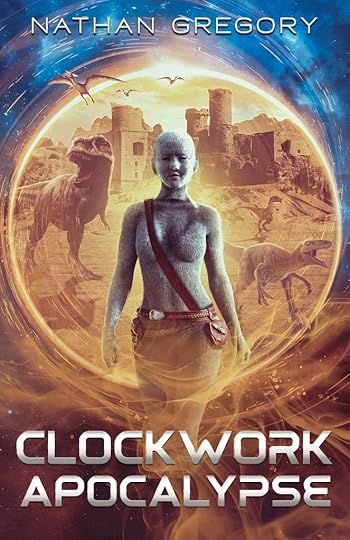
Clockwork Apocalypse blends high-stakes action with introspection, weaving a tale of resilience, humor, and hope against the backdrop of interstellar extinction. With elements of speculative science fiction, rich world-building, and mature themes, this novel invites readers to question the nature of sacrifice, the bonds of found family, and the price of survival in a universe where heroes can be made—but never without cost.
______________________________
About Kaye Lynne Booth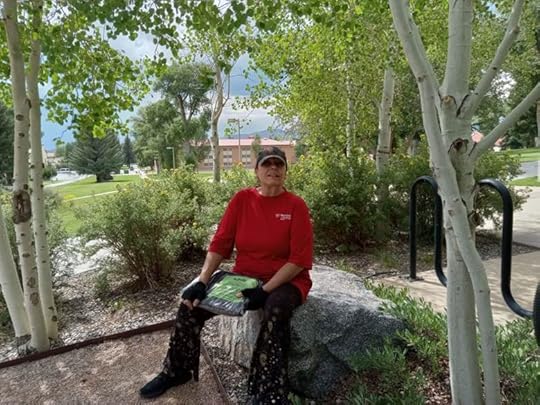
For Kaye Lynne Booth, writing is a passion. Kaye Lynne is an author with published short fiction and poetry, both online and in print, including her short story collection, Last Call and Other Short Fiction; and her paranormal mystery novella, Hidden Secrets; Books 1 & 2 of her Women in the West adventure series, Delilah and Sarah, and her Time-Travel Adventure novel, The Rock Star & The Outlaw,as well as her poetry collection, Small Wonders and The D.I.Y. Author writing resource. Kaye holds a dual M.F.A. degree in Creative Writing with emphasis in genre fiction and screenwriting, and an M.A. in publishing. Kaye Lynne is the founder of WordCrafter Quality Writing & Author Services and WordCrafter Press. She also maintains an authors’ blog and website, Writing to be Read, where she publishes content of interest in the literary world.
________________________________
Did you know you can sponsor your favorite blog series or even a single post with an advertisement for your book? Stop by the WtbR Sponsor Page and let me advertise your book, or you can make a donation to Writing to be Read for as little as a cup of coffee, If you’d like to show your support for this author and WordCrafter Press.
________________________________
This segment of “Chatting with New Blood” is sponsored by the Time Travel Adventure Series and WordCrafter Press.
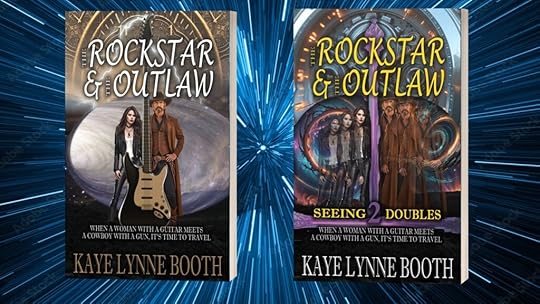
When a Girl with a Guitar Meets a Man with a Gun, It’s Time to Travel
The Rock Star & The Outlaw: https://www.amazon.com/Rock-Star-Outlaw-Time-Travel-Adventure-ebook/dp/B0CJBRRCN1/
The Rock Star & The Outlaw 2: Seeing Doubles: Coming Soon!
March 21, 2025
Book Review: Seventeen Days
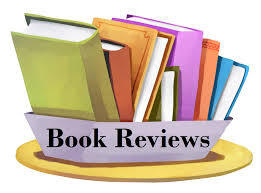 About Seventeen Days
About Seventeen Days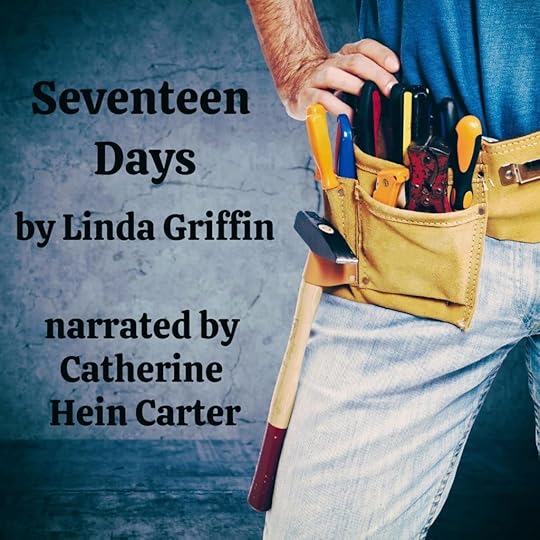
Divorcee Jenna Scott moves to a quiet California fishing village during the first Gulf War to make a new life in a house inherited from her grandfather. Her next-door neighbor recommends widowed handyman Rick Alvarez to fix her leaky roof. Jenna is intimidated by his good looks and annoyed by his self-assurance, but disarmed by his affection for his young son. She is still hurting from her ex-husband’s betrayal and resists the attraction between them.
Rick has lived in the village for only three years and is still an outsider, friendly but not sharing his past with anyone. When an attractive vacationer is murdered, local gossip says he is the killer, and rumors spread about his wife’s death as well. Jenna is determined not to believe the gossip, but will she ever be able to trust Rick with her wounded heart?
My Review of Seventeen DaysI received an audiobook copy of Seventeen Days, by Linda Griffin, and narrated by Catherine Hein Carter, in exchange for an honest review. All opinions stated here are my own.
I’ve reviewed several of Griffin’s audiobooks, but this is the second one narrated by Catherine Hein Carter, and I have to say that this narrator does a smashing job. Carter is my favorite of Griffin’s narrators, to be sure. You can read my other reviews of audiobooks by Linda Griffin here:
Love, Death and the Art of Cooking The Rebound Effect Guilty KnowledgeSeventeen Days is a sweet romance about a woman learning to trust after a hurtful divorce, and a widower with a young son trying to fit in to the small California fishing village, where a murder puts him in the spotlight as the prime suspect. Griffin does a smashing job of drawing the characters in a way that makes them feel familiar, making it easy to care about what happens to them.
Jenna is hurt and reluctant to place her trust in anyone after her relationship with her cheating ex-husband. But when she meets Rick, the local handyman, her feelings are torn. Rick’s relationship with his son, Aiden, endears her to him, although he strikes her as being a bit forward, and she finds herself wanting to give him her trust. But when there is a murder in the small town, suspicions are thrown onto the widower, who is still an outsider among them, and Jenna doesn’t know what to believe.
A romance mystery that will steal your heart. I give Seventeen Days five quills.

______________________________________
Kaye Lynne Booth does honest book reviews on Writing to be Read in exchange for ARCs. Have a book you’d like reviewed? You can request a review on the Book Review tab above.
March 18, 2025
Treasuring Poetry – Meet poet and author, Freya Pickard, and my book reviews #poetry #bookreviews

Today, I am delighted to feature poet and author, Freya Pickard, as my March Treasuring Poetry Guest. Freya is a great supporter of the WordPress poetry community and runs a bi-annual haiku challenge on her haiku blog which you can find here: https://purehaiku.wordpress.com/.
Welcome Freya.
What is your favourite style of poetry to read ie haiku, ballad, epic, freestyle, etc?I’m not sure I have a favourite style of poetry. I enjoy both modern and traditional haiku, as well as tanka and other short form poetry due to their ability to create startling, vivid images and contrasts. But I also enjoy other poetical forms, including free verse. I usually look for poetry that captures my imagination, that allows me to connect the dots without the poet telling me how I should feel or think or believe. I enjoy any kind of poetry that allows my inner being to connect with ideas and concepts too. My favourite reads from the last couple years include Linda Imbler’s “Twelvemonth” and Willow Croft’s “Quantum Singularity”. I’m also a huge fan of Italian poet, Claudia Messelodi and love her collections “Blue Moon” and “Sky-Blue Wisteria”. I also love JRR Tolkien’s epic poems, especially those in The Lays of Beleriand.
What is your favourite poem in your favourite style to read?A poem I return to again and again is The Lay of Leithian by JRR Tolkien. It tells of a tragic love story between a human man, Beren, and an immortal elf woman, Luthien. Their love is forbidden by Luthien’s father and the story covers many years of suffering for both protagonists. There are horrendous monsters and dark peril for both to overcome. Beren’s task is to obtain one of the elvish jewels, a Silmaril, and in doing so, he loses his life. If you’ve not read it, I won’t spoil it by telling you the ending, but it really is worth reading! (No, I’ve not seen The Rings of Power because I can’t stream images. Plus, I’ve seen trailers for it and the characters are not how I imagined them to look/act!)
I suppose this Lay satisfies my need for both poetry and stories. The narrative is also dark, which suits me fine, and contains both vampires and werewolves amongst the monsters who tread the shadows! The romance isn’t cloying and the ending is bittersweet, which, for me, is a true reflection of life. The Lay of Leithian is incredible long, so here are just a few excerpts which I love.
The first excerpt sets the scene for Luthien’s dancing beneath the moonlight:
There darkling stood a silent elm
And pale beneath its shadow-helm
There glimmered faint the umbels thick
Of hemlocks like a mist, and quick
The moths on pallid wings of white …
The second excerpt describes the vampire that haunts the tale:
A vampire shape with pinions vast
Screeching leaped from the ground and passed,
It’s dark blood dripping on the trees …
And the last excerpt describes one of the many fight scenes:
From shape to shape, from wolf to worm,
From monster to his own demon form,
Thu changes, but that desperate grip
He cannot shake, nor from it slip …
What is your favourite style of poetry to write?I write from my heart, how I feel, what I see, what I experience, so more often than not I write free verse. Sometimes this outpouring of poetry is rhythmical such as in
Down through the dewy woods, damp and leafy
Wading rivers that rush and whirl
Lost in the mist, in the moors and marshes
Stumbles at last to a steep-sided cliff…
Sometimes it rhymes:
I dream of mermaids, magic and myth,
Of silvery fish tails, immortal gifts,
Flaming red hair and liquid green eyes,
Of laughter and singing old sea-songs.
Songs that whisper of seaweed, wind-rippled sands
That tell of the monsters who walk on land,
That speak of Ancients who dwell in the deeps,
Hinting at languages no man can speak.
I dream of dolphins so free in the sea
Of the whale and the seahorse,
Of what might have been…
But normally I find a rhythm of words that reflects my emotion:
this blurred moment
when
hydrogen combines with
oxygen –
too much water
I drown
swiftly rising
I gasp
draw air
to resurrect myself
wavering
on the edge
I feel life
flickering
doused in moisture
I reach for the wind
bursting full
I skim, I dance
across this strange
ocean called
death
I do use poetic forms to express myself and have experimented with many different short forms in the past. My favourite styles are haiku, tanka and elfje because they are short and focus my attention on one thing at a time. I love haiku, particularly traditional haiku because it tests my ability to say something in just 17 syllables!
eggshell thin fragile
touch me and I will shatter
empty, blank inside
What is your favourite of your own poems?My favourite poem, so far in my life, is I, Vampire from my most recent poetry collection, Vampirical Verse. I, Vampire sums up how I feel post cancer and encapsulates the experience of near death, open surgery and chemotherapy too.
I understand emptiness
I feel no fear
no pain
no joy
no sorrow
I am hollowed out
what used to live within
has long since fled
yet still, I am not dead
unable to care
to be concerned
no heart beats within my breast
no hormones surge inside
I feel nothing –
un-dead yet un-alive
Please tell us about your poetry book trilogy, This Is Me. What is your main intention with this collection of poems?This Is Me boxset/paperback contains the frost three published volumes of my poetry. Each volume has a different reason for being in the collection.
Volume 1 – Insides
These poems were written between July 2014 and October 2015 and covers my near death experience of bowel cancer, open surgery, chemotherapy and the start of my recovery. Most days I wrote something in my journal, even if it was just one sentence. I found it hardest to write during chemo due to the utter exhaustion I experienced for 6 months. At other times I was lucid enough to experiment with poetic forms and often, some of my prose sentences became poems when I looked back in my journals during recovery. My intention in this section was to help people understand what it is like to go through the above-mentioned experiences.
Volume 2 – My Mythology
The poems in this section were written between 1990 and 2015. My intention was to allow readers an insight into the sources of my creative inspiration. Again I use free verse as well as poetical forms to explore biblical imagery, Nordic influences and tales of vampires, zombies and werewolves! These poems show others what is important to me as a prose writer as well.
Volume 3 – This Is Me
This section is a compendium of real-life and fantastical imaginings and were written between 1990 and 2017. I explore how important certain things are to me; dancing, writing, the seasons, being single, being married, having cancer, and, of course, reading! This volume gives readers a different kind of insight into my everyday life and routine.
All three volumes together form a poetical auto-biography that I think is more dynamic than a prose re-telling of my life so far. This Is Me was designed so that the reader can dip in an out of it as they wish, or read great chunks at one time if they so desire.
Anyone who reads this book will understand me, the real me!
My reviews of Insides and My Mythology by Freya PickardInsides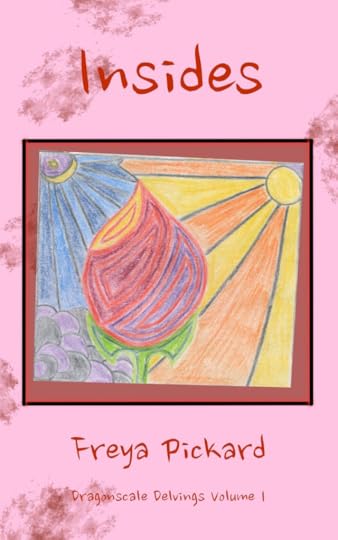 Picture caption: Book cover of Insides by Freya Pickard
Picture caption: Book cover of Insides by Freya PickardI have read several memoires of journeys through the horrors of cancer and its treatment and they have been very compelling. Depicting this journey using the short and powerful lines of poems took the poet’s experiences to a higher level of emotional involvement for me. Each poem is vivid and visceral and sliced right through my heart. I related deeply to the poet’s reaction to medical confirmation of cancer which took me back to my mother’s diagnosis of cancer. I couldn’t take about it for two weeks because the shock was so great.
This book comprises of four parts and I am going to share a poem or verse from a poem from each section to illustrate the gut wrenching power of these poems.
Part One Colostomy
Stoma-ached
“my insides on my outside,
red blancmange in jellied form,
dark innards encrusting
pale, tired flesh,
interruption of natural order –
raspberry flavoured belly belches.”
Part Two Surgery
“cancer;
cancer;
barren fruit
inside my flesh,
pierced through,
cut free,
removed from
within”
Part Three Chemotherapy
“frustration of not being able to do what I
want to do; no energy to do anything
this long haul of weariness seems never-ending
endless waiting, patiently sitting in three different
waiting rooms – checking my swollen arm for clots …”
Part Four Recovery
“fogged
landscape
reveals
my future path;
life”
The poems in this book depicting cancer in all its stark reality have stayed with me. They brought back my own memories of countless waits in hospital for news – sometimes good, sometimes not so good. It feels like I’ve spend a huge portion of my life waiting for outcomes. It was psychologically uplifting to me that Freya’s treatment process, unbelievably hard as it was, had a successful outcome.
Purchase Insides from Amazon US here: https://www.amazon.com/gp/product/B01M2UQAWJ
My Mythology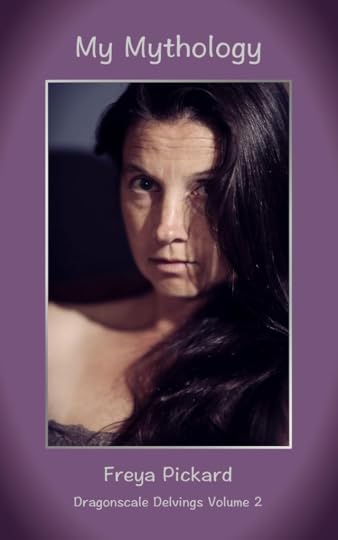
My Mythology delves into the poet’s interest in mythology and legends which is an important aspect of who she is as a person, poet, and writer. My mother is English and I was brought up on a diet of dragons, unicorns, Arthur and the knights of the round table, and other British myths and legends. My mother’s home town of Bungay has an array of ghosts and the church my mom attended as a girl is home to a famous story about the Black Shuck of Bungay. I knew all of these stories as a youngster and as I grew older, I expanded my interest into Greek and Norse mythology. As a result, I recognised many of the figures and creatures featured in this book.
The poet has written beautiful and lyrical word pictures and stories incorporating elements from various myths and legends, all of which are vivid and a delight to read. The poems are divided into ten sections: Roots, Imaginate, Oceansong, Legend, The Lizard, Fringes of Fear, Blank Mirror, Spectral Visions, Time & Space, and Deity.
I am going to share extracts from a few poems that particularly captivated me under the specific section heading.
Roots
“I am the lifting of your heart
I am a candle in the dark.
I am the cry of a new-born child
I am a cub in the bitter wild.”
from ‘Hope’
Oceansong
“The sun was dying through the mist
And in the waves that kissed the beach
Bright blue and purple, grey and green,
Tails flickered with a rainbow sheen.”
from ‘Shifting Wave of Green’
Legend
“metalled
horn spirals up
gleams between dark, liquid
eyes contrasting with his pale coat
that shines
with starlight, moonlight – luminous’
from ‘Silvered Constellation’
Deity
‘Air is
Breath of my sould,
That which will last beyond
My body’s destruction, living
Always.’
from Substance
This is a book for the dreamers of this world. Those of us that revel in the possibility of a bit of magic and wonder around the next corner. A superb book of gorgeous poems.
You can purchase My Mythology from Amazon US here: https://www.amazon.com/gp/product/B07NGQQ3DJ
About Freya Pickard Picture caption: author picture of Freya Pickard
Picture caption: author picture of Freya PickardPushcart Prize nominee, Freya Pickard is the quirky, unusual author of The Kaerling series, an epic fantasy set in the strange and wonderful world of Nirunen.
A cancer survivor, she writes mainly dark fantasy tales and creates expressive poetry in order to rest the prose side of her brain. Her aim in life is to enchant, entertain and engage with readers through her writing.
She finds her inspiration in the ocean, the moors, beautifully written books and vinyl music (particularly heavy metal and rock). Her most recent relaxation techniques to get her through lockdown include hatha yoga and painting landscapes and monsters in watercolour.
Find out more about Freya and her books at https://dragonscaleclippings.wordpress.com
Freya blogs at:
https://purehaiku.wordpress.com
https://dragonscaleclippings.wordpress.com
Her spoken word poetry and prose can be found at https://studio.youtube.com/playlist/PL9e82GWvh7Sxzb3LcN4iuHJjtZ0CVw3eB/videos
About Robbie Cheadle
South African author and illustrator, Robbie Cheadle, has written and illustrated sixteen children’s books, illustrated a further three children’s books, and written and illustrated three poetry books. Her work has also appeared in poetry and short story anthologies.
Robbie also has two novels and a collection of short stories published under the name of Roberta Eaton Cheadle and has horror, paranormal, and fantasy short stories featured in several anthologies under this name.
You can find Robbie Cheadle’s artwork, fondant and cake artwork, and all her books on her website here: https://www.robbiecheadle.co.za/
________________________
Did you know you can sponsor your favorite blog series or even a single post with an advertisement for your book? Stop by the WtbR Sponsor Page and let me advertise your book, or you can make a donation to Writing to be Read for as little as a cup of coffee, If you’d like to show your support for this author and WordCrafter Press.
__________________________
This segment of “Treasuring Poetry” is sponsored by WordCrafter Press and the Poetry Treasures series.

Get Your Copy Today!
Poetry Treasures: https://books2read.com/PoetryTreasures
Poetry Treasures 2: Relationships: https://books2read.com/PT2-Relationships
Poetry Treasures 3: Passions: https://books2read.com/u/b5qnBR
Poetry Treasures 4:In Touch With Nature: https://books2read.com/PT4-Nature
March 17, 2025
Mind Fields: This Is How I Think
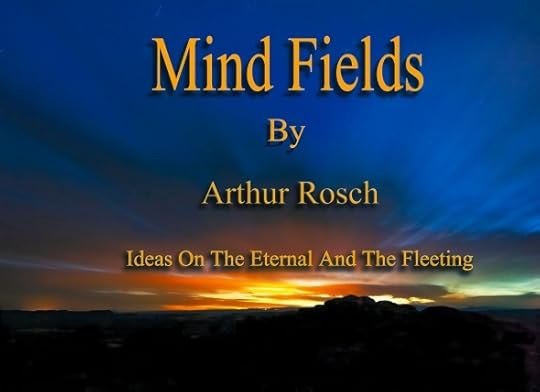
I have a bit of a crush on a woman. It’s harmless. I don’t plan to do anything about this crush. I have everything I need. We are colleagues in a psychotherapy group and some strange osmosis took place. We connected briefly. We shared one another’s status vis a vis relationships. Neither of us is “available”. For about a week I convinced myself that she was thinking about me. I sent a couple of emails that I now regret sending. I had the conceit that she was as enmeshed with me as I was enmeshed with her. I now ask myself this question: what made me think that I was important in this woman’s life?
I look at my own grandiosity. I thought it was banished from my psyche, but…uh oh…here it is again in a new form. Self-importance is not attractive. There are NO important people. Anywhere. If you think otherwise you haven’t grasped the sheer SCALE of existence. Consciousness is important because that’s what everything IS. The relative importance of a human being within the structure of consciousness is a passing conceit.
The grandeur, wisdom and compassion of the Highest Power is far far beyond our grasp. It is utterly inclusive and envelopes everything in the physical world, the soul world, the spirit world, in all the worlds. I use the word “world” as a metaphor for certain structures in the Realm of Everything. If this is a difficult concept, just imagine an onion made from layers of thought. The core of this onion resembles a stellar object, such as a Black hole. This Realm subsumes the Permanent and the Impermanent as complimentary aspects of The One Truth….or whatever you want to call it.
It’s refreshing to drop this facade of self-importance. I’ve got an ego. It’s pretty tattered and irrelevant at this point but it still holds sway in my psyche. I want to be admired, respected, loved, and I want, especially, to be understood. I also want to have the resources to return this regard with affection. I have not always been a warm person. This is an ability to connect with people in a way that is safe for everyone. Let’s just say that I’m getting there.
I have too much invested in my appearance. I’m in love with my own face. That isn’t always a bad thing. I am confident in my identity but I still have psychological problems. I hope to minimize my propensity for delusions, obsessions and over-excitement. I simply accept my problems as integral to my life’s narrative.
I can’t put it more succinctly than this: today I hope to be less ignorant and stupid than I was yesterday.
About Arthur RoschArthur Rosch is a novelist, musician, photographer and poet. His works are funny, memorable and often compelling. One reviewer said “He’s wicked and feisty, but when he gets you by the guts, he never lets go.” Listeners to his music have compared him to Frank Zappa, Tom Waits, Randy Newman or Mose Allison. These comparisons are flattering but deceptive. Rosch is a stylist, a complete original. His material ranges from sly wit to gripping political commentary.
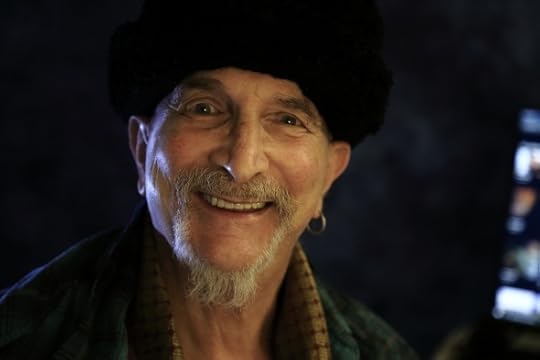
Arthur was born in the heart of Illinois and grew up in the western suburbs of St. Louis. In his teens he discovered his creative potential while hoping to please a girl. Though she left the scene, Arthur’s creativity stayed behind. In his early twenties he moved to San Francisco and took part in the thriving arts scene. His first literary sale was to Playboy Magazine. The piece went on to receive Playboy’s “Best Story of the Year” award.
Arthur also has writing credits in Exquisite Corpse, Shutterbug, eDigital, and Cat Fancy Magazine. He has written five novels, a memoir and a large collection of poetry. His autobiographical novel, Confessions Of An Honest Man won the Honorable Mention award from Writer’s Digest in 2016.
More of his work can be found at www.artrosch.com
Photos at https://500px.com/p/artsdigiphoto?view=photos
_______________________________________
Did you know you can sponsor your favorite blog series or even a single post with an advertisement for your book? Stop by the WtbR Sponsor Page and let me advertise your book, or you can make a donation to Writing to be Read for as little as a cup of coffee, If you’d like to show your support for this author and WordCrafter Press.
________________________________
This segment of “Mind Fields” is sponsored by the Roberta Writes blog site, where you can find the poetry, photos, videos, and book reviews by Robbie Cheadle and so much more.
March 14, 2025
Book Review: Draakensky
 About Draakensky
About Draakensky**Readers’ Choice Book Awards Finalist
Jon R. Meyers at The Horror Zine writes “Draakensky is a powerful, timeless piece of dark fiction . . . beautifully haunting. A book that is unique and stands out loudly from the rest. Highly recommended.”
A murder. A wind sorcerer. A dark spirit. In the shrouded realm of Draakensky Windmill Estate—where magic dictates destiny—reality and the supernatural blur.
THE MURDER: Heida Mead is found dead in the thrashing Mianus River in Bedford, New York.
THE WIND SORCERER: Jaa Morland is the reclusive spinster of Draakensky estate, a commanding wind-witch and deeply attuned to ghosts—and, she knows the meaning of owl sorcery.
THE DARK SPIRIT: A ghost hurls whispers into the fabric of Draakensky, stirring up secrets of river magic and untold horrors.

Purchase Link: https://www.amazon.com/Draakensky-Supernatural-Tale-Magick-Romance-ebook/dp/B0DCKBVQTV
My Review of DraakenskyI received a digital copy of Draakensky, by Paula Cappa in exchange for an honest review. All opinions stated here are my own.
This story has ghosts and witches and everything a gothic fantasy story needs, but the thing that captivated me the most about Draakensky is the owl imagery and lore. Cappa does an excellent job of weaving owl symbolism into the story, adding meaning and driving the story forward.
When Heida Mead is murdered under mysterious circumstances, Charlotte Knight is commissioned to complete the illustrations on the book of Rilke’s poetry that she had been working on under the direction of Heida’s sister, Jaa Moorland. She accepts and comes to the Draakensky windmill, in Bedford Village, New York, in hopes of launching a new path in her career, away from the hustle and bustle of Chicago and a cheating boyfriend.
But Jaa is difficult to deal with, at times seeming deranged and unreasonable, with Charlotte’s career hanging in the balance. With nothing left to go back to, Charlotte is determined to stick it out, even as strange events begin to occur which could be downright dangerous. Voices in the cottage, a foreboding groundskeeper, a strange white wolf, menacing owl attacks, and speculations about the murder around every corner. There is magick in the wind, and in the river, and in the very soil of Draakensky, and it controls the animals and the elements, even from beyond the grave.
An outstanding gothic horror mystery. I give Draakensky five quills.

__________________________________
Kaye Lynne Booth does honest book reviews on Writing to be Read in exchange for ARCs. Have a book you’d like reviewed? You can request a review on the Book Review tab above.
March 11, 2025
Read and Cook with Robbie Cheadle – The Museum of Ordinary People by Mike Gayle and Toad in the Hole #fiction #cooking
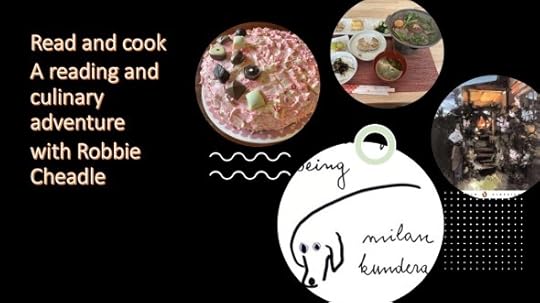 The Museum of Ordinary People by Mike Gayle
The Museum of Ordinary People by Mike Gayle
 Picture caption: Cover of The Museum of Ordinary People showing people organising display items in a room against a yellow backgroundWhat Amazon says
Picture caption: Cover of The Museum of Ordinary People showing people organising display items in a room against a yellow backgroundWhat Amazon saysStill reeling from the sudden death of her mother, Jess is about to do the hardest thing she’s ever done: empty her childhood home so that it can be sold. As she sorts through a lifetime of memories, everything comes to a halt when she comes across something she just can’t part with: an old set of encyclopedias. To the world, the books are outdated and ready to be recycled. To Jess, they represent love and the future that her mother always wanted her to have.
In the process of finding the books a new home, Jess discovers an unusual archive of letters, photographs, and curious housed in a warehouse and known as the Museum of Ordinary People. Irresistibly drawn, she becomes the museum’s unofficial custodian, along with the warehouse’s mysterious owner. As they delve into the history of objects in their care, they not only unravel heart-stirring stories that span generations and continents, but also unearth long-buried secrets that lie closer to home.
Inspired by an abandoned box of mementos, The Museum of Ordinary People is a poignant novel about memory and loss, the things we leave behind, and the future we create for ourselves.
Most people have items in their lives that are special to them. Items that may not hold a high numerical value but which represent a special time and/or memory in their lives. These are the things we all try to hold on to over the course of our lives. The things stored in a memory suitcase or box that we would save first in the event of a fire or disaster. These are the things that constitute the Museum of Ordinary People.
This book is an extraordinary idea that builds on the concept of beloved possessions with which we do not want to part when someone dies, but which we may not have the space or ability to keep. The author has built a heartfelt and brilliant story around the interesting idea of a museum where these special items from ordinary people can be housed and displayed.
Jess Baxter grow up in Northampton in a single parent family. Her mother is incredibly dear to her and when she dies unexpectedly, Jess is overwhelmed with grief. Jess is left with the dreadful job of going through her mother’s possessions and disposing of them in order to empty her home, ready for sale. With the help of her best friend, Luce, Jess manages to get this task completed, but she hangs on to a set of battered and well used encyclopedias from her childhood. She takes them home to the posh London flat she shares with her boyfriend, Guy, and stores them for a period to time. A year later, Guy decides they should formalise their relationship and purchase a house together. Jess is faced with having to get rid of the encyclopedias. A search uncovers the existence of The Museum of Ordinary People and Jess decides to take the encyclopedias there where they will be safely stored. When she arrives, she finds that the owner has recently died and his business, including the museum, have been inherited by a man called Alex. Alex has terrible scars which have impacted his whole life and turned him into an introvert. Alex doesn’t know what to do with the museum and Jess desperately wants to save it. She also sees the museum as an opportunity for her to act in the capacity of curator of her own museum, a position she has dreamed of. Jess persuades Alex to give her a chance to turn the museum into a money-making venture.
Jess is a lovely character. She is anxious and full of self doubt but she has an inner strength that comes out strongly over the course of the book. She has made some mistakes including her involvement with Guy who is stifling her creativity and preventing her from pursuing her dream. Jess has the strength of character to go against Guy’s wishes and follow her dream which I really enjoyed. She demonstrates determination, a great work ethic and ability to achieve success in difficult circumstances. As the novel progresses, Jess also gets a second chance at love.
A thoroughly entertaining read with a strong female main character.
You can purchase The Museum of Ordinary People here: https://www.amazon.com/gp/product/1538740842
Toad in the Hole, a traditional British recipeThis recipe is available for free on line from Tin Eats here: https://www.recipetineats.com/toad-in-the-hole/
Ingredients (I made double of the Toad in the Hole)16 pork sausages (pricked on both sides)
Olive oil for cooking the sausages
Yorkshire pudding batter500 ml egg (I used 10 1/2 eggs) – you need to measure the egg
500 grams all purpose or plain flour
375 ml milk
125 ml cold water
2 Tbspns mayonnaise
1 tspn salt
White pepper to taste
100 ml olive oil
Onion gravy (I did not double this part of the recipe)Sausage fat and olive oil for frying
1 large red onion chopped
1 tspn garlic flakes
45 ml all purpose or plain flour
500 ml beef stock
5 ml Worcestershire sauce
Black pepper to taste
MethodIn a bowl, whisk the flour into the egg. I used an electric mixer. Add the cold water, milk, mayonnaise, salt and pepper. Mix until smooth. Place in the refrigerator.
In a frying pan, brown the sausages in a little olive oil. Retain the sausage fat.
Heat the oven to 220C. Place the olive oil (100 ml) into a baking pan and place in the oven for c. 10 minutes. When sizzling hot, remove carefully from the oven and quickly place the sausages all around the pan. Pour over the batter and replace in the oven to cook for c. 35 minutes until golden brown.
 Picture caption: Toad in the hole ready to be baked in the oven
Picture caption: Toad in the hole ready to be baked in the ovenAdd some olive oil to the sausage fat and cook the onion. Mix in the flour, garlic and black pepper. Add the beef stock stirring continuously. It will thicken quickly. Add the Worcestershire sauce.
 Picture caption: Onion gravy
Picture caption: Onion gravyServe immediately.
 Picture caption: Baked toad in the hole
Picture caption: Baked toad in the hole
 Picture caption: A serving of toad in the hole with onion gravyAbout Robbie Cheadle
Picture caption: A serving of toad in the hole with onion gravyAbout Robbie Cheadle

South African author and illustrator, Robbie Cheadle, has written and illustrated seventeen children’s books, illustrated a further three children’s books, and written and illustrated three poetry books. Her work has also appeared in poetry and short story anthologies.
Robbie also has two novels and a collection of short stories published under the name of Roberta Eaton Cheadle and has horror, paranormal, and fantasy short stories featured in several anthologies under this name.
You can find Robbie Cheadle’s artwork, fondant and cake artwork, and all her books on her website here: https://www.robbiecheadle.co.za/
_______________________________________
Did you know you can sponsor your favorite blog series or even a single post with an advertisement for your book? Stop by the WtbR Sponsor Page and let me advertise your book, or you can make a donation to Writing to be Read for as little as a cup of coffee, If you’d like to show your support for this author and WordCrafter Press.
_______________________________________
This post is sponsored by the My Backyard Friends Kid’s Book Series and WordCrafter Press .
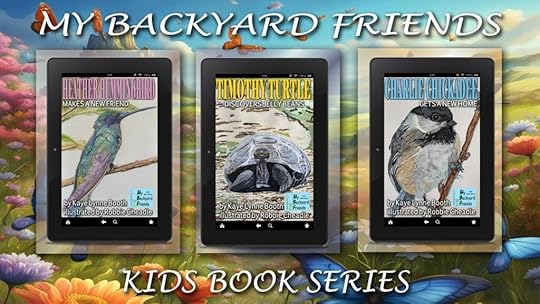
The My Backyard Friends kid’s book series is inspired by the birds and animals that visit the author Kaye Lynne Booth’s mountain home. Beautiful illustrations by children’s author, poet, and illustrator, Robbie Cheadle, bring the unique voices of the animal characters to life.
Get Your Copy Now.
Heather Hummingbird Makes a New Friend (Ages 3-5): https://books2read.com/MBF-HeatherHummingbird
Timothy Turtle Discovers Jellybeans (Ages 3-5): https://books2read.com/MBF-TimothyTurtle
Charlie Chickadee Gets a New Home (Ages 6-8): https://books2read.com/MBF-CharlieChickadee
March 10, 2025
Everyone is a Critic: “Tale of Tales”
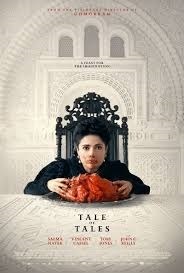
Three kingdoms. Three horrific tales, braided into one tragically horrendous fairytale in the classic tradition, Tale of Tales is a skillfully crafted triple fairytale. Fairytales were used to frighten children into behaving themselves in days of past. They are supposed to strike fear in readers, or in this case, viewers, so the element of horror is no surprise here. Everyone knows fairytales are tales of tragedy and don’t always have a happy ending. Even when they do have a HEA, the characters must face gruesomely frightening trials to reach that point.
A King (John C. Riley) and Queen (Selma Hayak) of the kingdom of Longtrellis are barren and will stop at nothing to have a son. The Queen summons a necromancer to make her wish come true. Upon his instruction, the King slays the sea monster, but loses his life. None-the-less, she eats the sea monster’s heart and bears a son, Elias Christian Lees, with alabaster skin and hair. At the same time as the cook bears a son, Jonah (Jonah Lees), who looks enough like Elias to be his identical twin, and the two boys grow up to become fast friends who are inseparable. Enraged after the boys fool her, the Queen sends the cook and her son away, but the boys’ bond is stronger, and when her son, Elias, fears his friend is in trouble, he runs away to go to his aid. Desperate for the return of Elias, the Queen summons the necromancer once more. She will have her son back, but at what price?
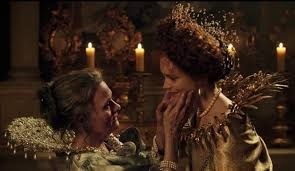
The King of the kingdom of Strongcliff (Vincent Cassell) becomes lustful when he hears a beautiful voice and must have the singer as his wife. But the singer is one of two sisters, aged spinsters, Imma (Shirley Henderson) and Dora (Haley Carmichael), who fool the King and he unwittingly takes Dora to his bed under her insistence that it be in complete darkness. Enraged upon waking and discovering her true appearance, the King has his guards throw her from the cliffside castle window, but Dora survives and is found by a witch who suckles her, giving her back her youth. The King and his hunting party found the beautiful young woman (Stacy Martin) laying on the forest floor and he falls in love and makes Dora his Queen. But Imma is lonely and longs to have her sister back with her, threatening to reveal Dora’s secret. Dora turns Imma away, leaving her alone to suffer a tragic end.
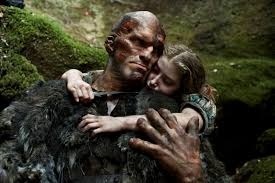
The King of the kingdom of Highhills (Toby Jones) becomes fascinated with a flea and makes it a pet that grows to gargantuan proportions. When his daughter, Violet (Bebe Cave), wishes to be married, he develops a plan to make her happy without risking losing her by placing the fleas hide on his wall and promising her hand to any suiter who can guess the creature that it came from. But it leads to the loss of his daughter when an ogre (Guillaume Delaunay) guesses correctly by smell, and he is forced to give Violet to the ogre, who takes her to his cave in the side of a high cliff. She’s recued by a family of acrobats, but the ogre slays them all and Violet fools the ogre and slits his throat. She returns to the kingdom, to find her father ill, and presents him with the head of the husband that he chose for her.
Official Clip: https://images.app.goo.gl/pAFnUmGSwCHFgcXo6
The three kingdoms and their tales are brought together at Violet’s coronation, where representing Longtrellis, Elias is in attendance, as well as the King of Strongcliff and his new Queen. But the witch’s magic wears off and Dora loses her youthful appearance and sneaks away unnoticed.
_____________________________

For Kaye Lynne Booth, writing is a passion. Kaye Lynne is an author with published short fiction and poetry, both online and in print, including her short story collection, Last Call and Other Short Fiction; and her paranormal mystery novella, Hidden Secrets; Books 1 & 2 of her Women in the West adventure series, Delilah and Sarah, and her Time-Travel Adventure novel, The Rock Star & The Outlaw, her the first three books in her kid’s book series, My Backyard Friends, her poetry collection, Small Wonders, and her writer’s resource, The D.I.Y. Author. Kaye holds a dual M.F.A. degree in Creative Writing with emphasis in genre fiction and screenwriting, and an M.A. in publishing. Kaye Lynne is the founder of WordCrafter Quality Writing & Author Services and WordCrafter Press. She also maintains an authors’ blog and website, Writing to be Read, where she publishes content of interest in the literary world.
_______________________________
Did you know you can sponsor your favorite blog series or even a single post with an advertisement for your book? Stop by the WtbR Sponsor Page and let me advertise your book, or you can make a donation to Writing to be Read for as little as a cup of coffee, If you’d like to show your support for this author and WordCrafter Press.
________________________________
This segment of “Everyone is a Critic” is sponsored by the Midnight Anthology Series and WordCrafter Press .

Midnight Roost: Weird and Creepy Stories: 20 authors bring your nightmares to life in 23 stories of ghosts, paranormal phenomenon and the horror from the dark crevasses of their minds. Stories of stalkers, both human and supernatural, possession and occult rituals, alien visitations of the strange kind, and ghostly tales that will give you goosebumps. These are the tales that will make you fear the dark. Read them at the Midnight Roost… if you dare. https://www.amazon.com/Midnight-Roost-Kaye-Lynne-Booth-ebook/dp/B0CL6FPLVJ
Midnight Garden: Where Dark Tales Grow: 17 authors bring you 21 magnificent dark tales. Stories of magic, monsters and mayhem. Tales of murder and madness which will make your skin crawl. These are the tales that explore your darkest fears. Read them in the Midnight Garden… if you dare. https://www.amazon.com/Midnight-Garden-Where-Tales-Anthology-ebook/dp/B0DJNDQJD3
March 8, 2025
Chatting with the Pros: Multi-Genre Author, Tom Benson
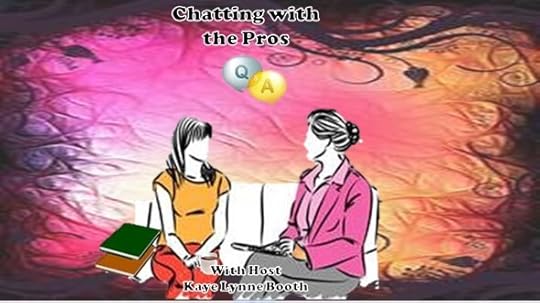
I met Tom Benson through an author’s group on Facebook, and he has since become a frequent visitor here, on Writing to be Read. Come to find out, Tom has been at this writing thing for almost a decade, and has several books out there in at least three different genres.
About Tom Benson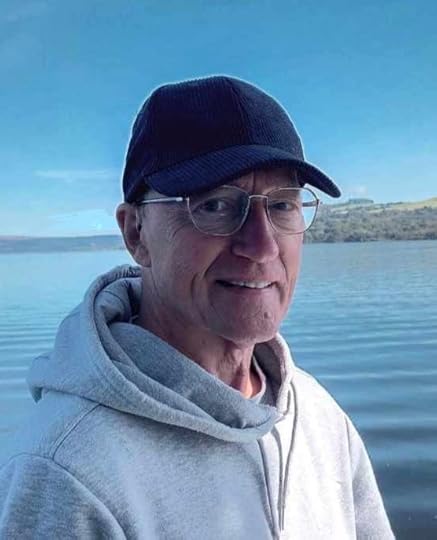
In 1969 at the age of 17, Tom left his native Glasgow to join the British Army. Tom’s military career spanned from 1969 to 1992. He followed this with a career in Retail Management, in which he was employed from 1992 to 2012.
Tom has been writing since 2007.
He has published novels, anthologies of short stories, a five-part novel, a variety of erotica books, and a series of genre-based poetry.
Tom is presently working on more novels.
My Interview with Tom BensonKaye: Your Light at the End series is categorized in the metaphysical science fiction sub-genre category. I’d never heard of that particular sub-genre. Can you talk a little about what attributes define metaphysical science fiction?
Tom: In simple terms, it’s a branch of philosophy that deals with life beyond what we know or see (usually, but not exclusively, the supernatural). This broad label includes existence, space, cause and effect, and more. Although there would be nothing supernatural in my story, because of the change of circumstances I intended for my characters, I felt the sub-genre was a good fit.
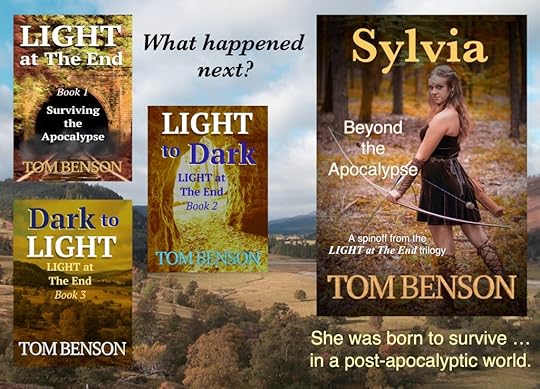
Kaye: The Light at The End series might also be categorized as post-apocalyptic science fiction. Right? Why don’t you tell us a little about that series?
Tom: Apart from short stories, I’d never written in this genre, until I was inspired when visiting Cruachan Power Station. Cruachan is a functional hydroelectric installation operating from within a mountain in Scotland. My story sees a coachload of tourists taking shelter from the start of a nuclear war inside a railway tunnel within a mountain. They’re compelled to investigate the tunnel when the entrance collapses behind them. Without giving spoilers, as they learn about their new environment, they also learn to depend on each other for survival. The group begins a new life inside the mountain. I intended it to be one book, but it grew as I developed the story, and it’s become a popular trilogy with a spinoff, Sylvia.
Kaye: Ten Days in Panama is classified on Amazon as both thriller and romance genres. I think it is brilliant that you combined the two genres and then used both in your keyword selections to broaden your reading audience instead of focusing on one, to the exclusion of the other as many authors choose to do. Of course, the story came first, and you just capitalized on what you had. Tell us a little about this story, and how you ended up combining these two genres?
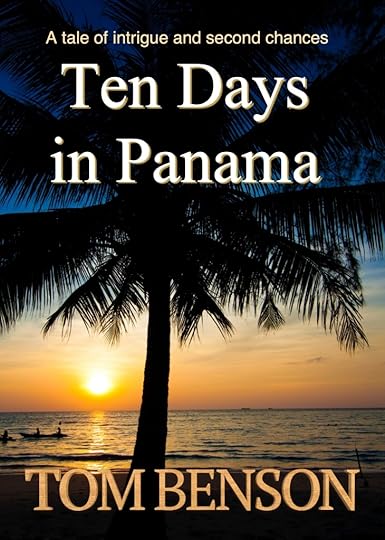
Tom: I opened with a British investigative reporter keen to follow up on a big story, and he needed the help of an expert in marine biology. He chose a female scientist in Panama, and they arranged to meet there. I wanted the thrust of the story to be a thriller, whereby the reporter’s life was under threat, but I saw the opportunity for a ‘will they, won’t they?’ scenario between the two main characters. I’m a Scotsman who lives in England, and I’ve never been to Panama. However, my friend Carmen Lopez, (a fellow author) lives in Panama, and she is a microbiologist. She was incredibly useful in helping me with various aspects of research. Carmen was also a wonderful sounding board as I developed the relationship between the main characters.
Kaye: You also write military stories and poetry. Would I be correct in assuming these come from your own personal experience serving in the military?
Tom: Yes, some of my military poetry is based on personal experience, and some is fiction. My military short stories, too, include factual tales, but others are fictional. The series, A Life of Choice, is my military memoir detailing my 23-year career in the British Army. The digital edition is a series of five eBooks.
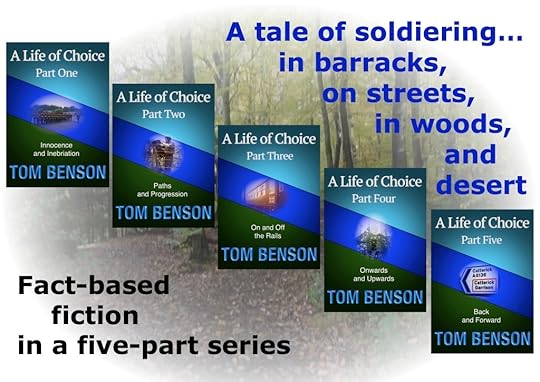
Kaye: Many of your protagonists are female. Why have you chosen females to take the lead in your stories?
Tom: In the 1960s, as a young teen, I was a fan of The Man from U.N.C.L.E.. Apart from the TV series, at around that time, I began to read everything I could about clandestine operations and international espionage. When The Girl from U.N.C.L.E. screened for one season, I was fascinated to see April Dancer (Stefanie Powers) demonstrating that a woman could be as capable as a man in the covert role. I bought all the ‘U.N.C.L.E.’ books, and the idea of a modern heroine remained a favourite in my mind. It should be remembered that many of the Special Operations Executive (SOE) operatives during WWII were courageous young women. In the late 90s, I saw The Long Kiss Goodnight (starring Geena Davis), which remains one of my favourite films. There are now many films and series in which the lead is a woman, whether an assassin, a vigilante, a resistance fighter or working with law enforcement. I believe it’s important to remember that it’s not only men who can demonstrate courage or participate in clandestine missions.
Kaye: What do you do to get into the female perspective for your characters?
Tom: I found it difficult at first, but I practised with short stories and acquired plenty of feedback from female readers. As I do with all of my stories, I build a character profile so that by the time the character hits the page, I know their full description, likes, dislikes, strengths, weaknesses, wardrobe (including disguises), favourite weapons, vehicles and, importantly, their past and how they became who they are. I give a female lead all the characteristics I admire in a woman and reinforce that with a no-nonsense attitude and a suitable background. I strive not to let a female character become a sex object, although occasionally, it helps with certain situations in which she might gain the upper hand.
Kaye: The A Taste of Honey series is your most recent. It’s a crime thriller, but it’s more about vigilante justice. Would you like to tell us about that series?
My aim with the first book was twofold: to create a hard-hitting vigilante thriller using a female lead and to set it in the US for various reasons. The premise is that ‘Honey’ is an NYPD detective who is awoken by a call from her sister’s cellphone, but it isn’t her sister’s voice she hears. The detective drives across the country to Greensburg, Indiana. In the basement of the family home, she finds a scene of abuse and torture. She also finds clues as to who was responsible. Honey crosses the line and sets out on a mission of vengeance, which takes her to different states. The sequel, Another Taste of Honey, sees the ex-detective fly to Europe to search for two men who evaded her in the US. While in Europe, several others make the mistake of tangling with Honey—a woman on a mission.
Kaye: What is the best piece of writing advice you were ever given?
Tom: In my early efforts writing short stories, a fellow author told me feedback wasn’t always positive, so I ought to ‘get used to taking the knocks’. I learned to differentiate between criticism for the sake of it and constructive criticism. When mentoring a novice writer, I expand on the advice I was given. I suggest to any new scribe that ‘Acting on genuine feedback can have a positive effect on your writing.’ An important piece of advice is given in Stephen King’s excellent book, On Writing: ‘If you don’t have time to read, you don’t have time to write.’
Kaye: As a multi-genre author, what do you find is most difficult about marketing your books?
The short answer—justifying the cost of advertising. The long answer—I quickly learned that getting a foothold in the market was difficult, with only one or two titles published. I paid for my first author’s website, my early covers, and advertising. Making money has never been my incentive when writing, but I had a major rethink when considering how much I paid out with little return. I recognised that my main marketing tool didn’t have to cost me anything but time and effort. After the first couple of years, with more titles published, I concentrated on strengthening my brand—which I believe is an author’s main marketing tool. I created a new website, practised and designed new book covers, and stopped paying for publicity. Since then, my only advertising has been on social media; it’s free, and with many more books published in different genres, I’m only dependent on reviews and recommendations. I created laminated bookmarks myself, which I include when sending a paperback edition to a charity. I have also paid for business cards to be made so they can be left in restaurants, cafes, and campsites here in the UK or in Europe when I visit.
Kaye: Where can readers learn more about you and your books?
Tom: I was a poet and regular blogger in my early creative writing days, and though my poetry and blogging have eased off, I maintain a writing blog at www.tombensoncreative.com. I also have an author website I created myself at www.tombensonauthor.com
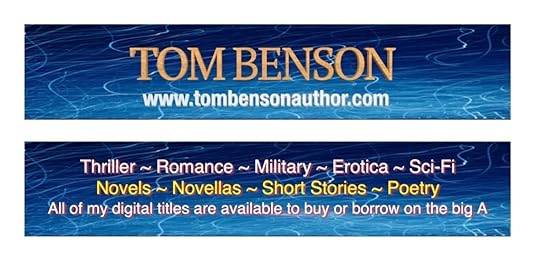
Thank you, Kaye, for the opportunity to reach a wider audience regarding my writing, and I hope your readers enjoy this article.
About the A Taste of Honey Series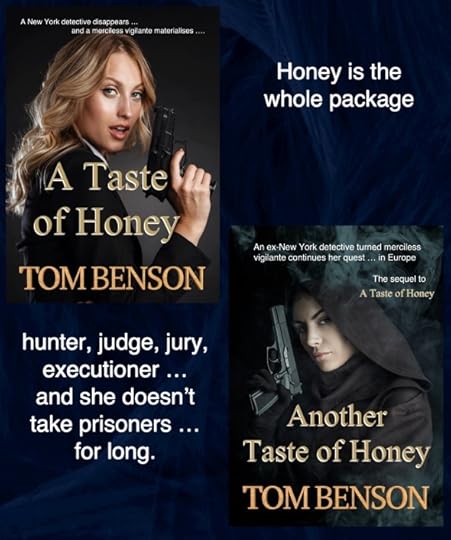
Purchase Link: https://www.amazon.com/dp/B0DQ9GSW4S?binding=kindle_edition&ref_=ast_author_bsi
My Review of the A Taste of Honey SeriesI received digital copies of A Taste of Honey and Another Taste of Honey, by Tom Benson, in exchange for an honest review. All opinions stated here are my own.
This series features a strong female protagonist, which is always a plus for me, and Benson does a nice job of making her believable, giving her an appropriate backstory as a police operative gone rouge, and plenty of friends to help her along the way. Honey Woods is on the hunt for the men who tortured and killed her younger sister in her previous life as Police Detective Kimberly Forest. She is an expert marksman, a master of disguises and seasoned law operative, and she still takes time for a morning run each day to stay in shape for the seemingly impossible tasks which lie ahead.
When Kimberly finds her sister’s tortured body in a basement dungeon, she vows to stop at nothing to get justice for what they’ve done to her sister and other young girls like her. She leaves her old life behind, acquiring a new identity as Honey, and everything begins to fall conveniently into place.
Her search for justice leads her to a ring of men, pillars of the community, who have been kidnapping, abusing and murdering young girls for a very long time, as well as other deserving recipients of her unique style of justice in A Taste of Honey. In Another Taste of Honey, our heroine travels to Europe in pursuit of the remaining two members of the ring still needing to be held accountable. When you’re on the receiving end of Honey’s justice, it may not be so sweet.
I strongly suggest reading these books in sequence, as I suspect I’d have a more difficult time relating with the character had I not already known her motivations. If the reader doesn’t understand this character, they might mistake her for a villain as she humiliates and emaciates her opponents.
This series provides an entertaining read that keeps readers guessing as to what devious, but fitting treatment Honey will serve to her next target. I give the A Taste of Honey series four quills.

___________________________________________
Did you know you can sponsor your favorite blog series or even a single post with an advertisement for your book? Stop by the WtbR Sponsor Page and let me advertise your book, or you can make a donation to Writing to be Read for as little as a cup of coffee, If you’d like to show your support for this author and WordCrafter Press.
_______________________________________
This segment of “Chatting with the Pros” with Kaye Lynne Booth is sponsored by The Women in the West Adventure Series and WordCrafter Press.

Historical Women’s Fiction
Get Your Copy Today!
Delilah: https://books2read.com/DelilahWiW1
Sarah: https://books2read.com/Sarah-Women-in-the-West
Marta: Coming in 2025
Writing to be Read
- Kaye Lynne Booth's profile
- 37 followers



